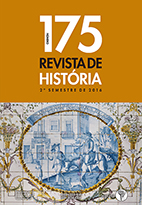Robert Southey, William Robertson and the four stage theory in the construction of the history of the native american's macro-narrative
DOI:
https://doi.org/10.11606/issn.2316-9141.rh.2016.111112Keywords:
Robert Southey, William Robertson, four stages theoryAbstract
The aim of this article is to analyze how the articulation of the four stages theory served as a backdrop in Robert Southey’ History of Brazil (1810-1819) for the examination of the populations living in Brazil, Rio de la Plata and Paraguay. In addition, I try to show the importance of William Robertson’ History of America (1777) for the insertion of American history within the macronarrative of world history through the constituency of indigenous peoples as morally wild and living in the stage of hunters and gatherers. The explanatory plan of the theory of the stages of society, the result of a great interest in the social sphere and the ethnography, was conceived as an attempt to elucidate the question of how some societies had reached civilization, while others languished in barbarism or even savagery. In that horizon of division of societies in barbaric, savage or civilized, the Robertson’ History of America was decisive for the construction of the Native American people as living in a wild state. The sociological and ethnographic approach, based on the mode subsistence’ description and how this affected the customs and manners of the people, came to be prescriptive to explain the status of the population not only in Europe but also in the New World. Southey continued to explore the ways and wild costumes, performing a significant broadening of topics and scrutinizing the peculiarities of various tribes without, however, fail to point their livelihoods, which were developed according to pre-defined stages.Downloads
Download data is not yet available.
Downloads
Published
2016-12-20
Issue
Section
Articles
License
Autores que publicam nesta revista concordam com os seguintes termos:
- Autores mantém os direitos autorais e concedem à revista o direito de primeira publicação, com o trabalho simultaneamente licenciado sob a https://creativecommons.org/licenses/by/4.0/ (CC BY). Esta licença permite que outros distribuam, remixem, adaptem e criem a partir do seu trabalho, mesmo para fins comerciais, desde que lhe atribuam o devido crédito pela criação original. É a licença mais flexível de todas as licenças disponíveis. É recomendada para maximizar a disseminação e uso dos materiais licenciados.
- Autores têm autorização para assumir contratos adicionais separadamente, para distribuição não-exclusiva da versão do trabalho publicada nesta revista (ex.: publicar em repositório institucional ou como capítulo de livro), com reconhecimento de autoria e publicação inicial nesta revista.
- Autores têm permissão e são estimulados a publicar e distribuir seu trabalho online (ex.: em repositórios institucionais ou na sua página pessoal) a qualquer ponto antes ou durante o processo editorial, já que isso pode gerar alterações produtivas, bem como aumentar o impacto e a citação do trabalho publicado (veja O Efeito do Acesso Livre).
How to Cite
VARELLA, Flávia Florentino. Robert Southey, William Robertson and the four stage theory in the construction of the history of the native american’s macro-narrative. Revista de História, São Paulo, n. 175, p. 349–384, 2016. DOI: 10.11606/issn.2316-9141.rh.2016.111112. Disponível em: https://revistas.usp.br/revhistoria/article/view/111112.. Acesso em: 21 nov. 2024.

















